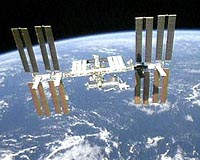 |
Oslo, Norway (SPX) Sep 14, 2009 The Norwegian Automatic Identification System (NORAIS) is an advancement on AIS, the short range coastal traffic system used by ships and Vessel Traffic Services around the world. AIS is required to be fitted on every seagoing vessel of 300 gross tons or more. It is both intended to help ship crews to avoid collision with other vessels and allow maritime authorities to track and monitor ship movements. NORAIS is bound for Columbus, the European space laboratory on the International Space Station. This winter a specially constructed antennae will be brought to the ISS and fitted on the outside of Columbus. From then on, the testing of NORAIS will start.
Global sea monitoring Today's AIS allows ships to communicate with other ships and land based base stations through VHF signals. This means that it is not possible to communicate outside the field of vision. The ISS has free vision over vast sea areas. Therefore the NORAIS can keep track of a much larger quantity of signals than the base stations on Earth. Researchers and engineers will use the signals to improve on the methods used to separate the signals from each other. In this way, ship traffic in a large area or from a long distance, can be monitored. The instrument is developed by Kongsberg Seatex and the Norwegian Defence Research Establishment (FFI) in cooperation with other partners.
Built in a year NORAIS was built in a year. The fast development phase was partly due to the construction of its twin, made for use in a satellite. This particular instrument will be situated in the Norwegian nano satellite AISSat-1, also developed by Kongsberg Seatex and FFI. AISSat-1 will perform similar measurements as NORAIS, but the data will be downloaded in real time under different conditions. "We are looking forward to space qualify this type of AIS receiver, which will pave the way for an even more advanced AIS receiver. AIS instruments will be an important element of the ESA In-Orbit-Demonstration programme, which is important for Norway," says Bjorn Ottar Elseth, Senior Adviser for Industry at the Norwegian Space Centre. Share This Article With Planet Earth
Related Links Norwegian Space Centre Station at NASA Station and More at Roscosmos S.P. Korolev RSC Energia Watch NASA TV via Space.TV Space Station News at Space-Travel.Com
 Russia Approves New ISS Crew
Russia Approves New ISS CrewStar City, Russia (RIA Novosti) Sep 11, 2009 A special commission has announced the composition of the main and backup crews for the next mission to the International Space Station (ISS). Russia's Soyuz-FG carrier rocket bearing the Soyuz TMA-16 spacecraft is due for liftoff from the Baikonur space center in Kazakhstan on September 30. The main crew comprises Russian astronaut Maxim Surayev and Jeff Williams from the U.S. ... read more |
|
| The content herein, unless otherwise known to be public domain, are Copyright 1995-2009 - SpaceDaily. AFP and UPI Wire Stories are copyright Agence France-Presse and United Press International. ESA Portal Reports are copyright European Space Agency. All NASA sourced material is public domain. Additional copyrights may apply in whole or part to other bona fide parties. Advertising does not imply endorsement,agreement or approval of any opinions, statements or information provided by SpaceDaily on any Web page published or hosted by SpaceDaily. Privacy Statement |